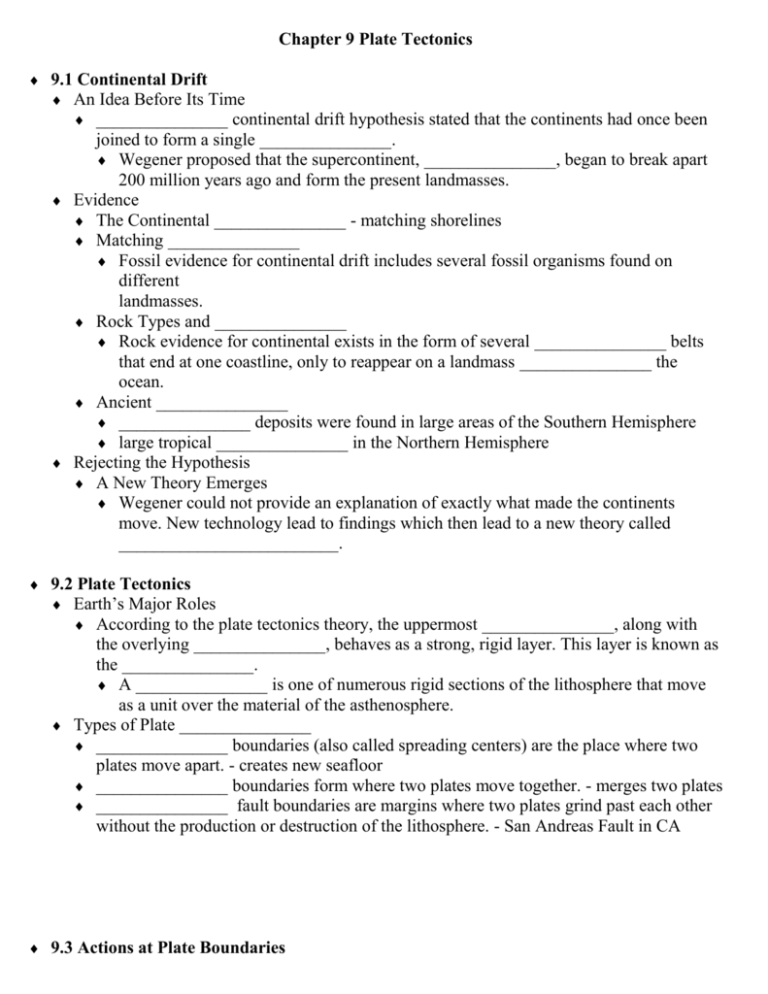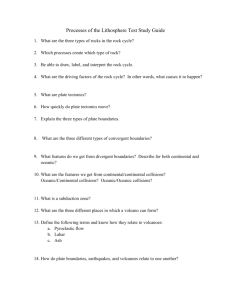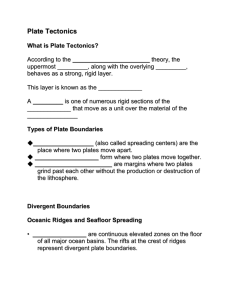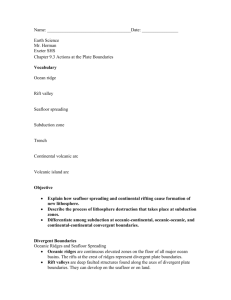Chapter 9 Plate Tectonics
advertisement

Chapter 9 Plate Tectonics 9.1 Continental Drift An Idea Before Its Time _______________ continental drift hypothesis stated that the continents had once been joined to form a single _______________. Wegener proposed that the supercontinent, _______________, began to break apart 200 million years ago and form the present landmasses. Evidence The Continental _______________ - matching shorelines Matching _______________ Fossil evidence for continental drift includes several fossil organisms found on different landmasses. Rock Types and _______________ Rock evidence for continental exists in the form of several _______________ belts that end at one coastline, only to reappear on a landmass _______________ the ocean. Ancient _______________ _______________ deposits were found in large areas of the Southern Hemisphere large tropical _______________ in the Northern Hemisphere Rejecting the Hypothesis A New Theory Emerges Wegener could not provide an explanation of exactly what made the continents move. New technology lead to findings which then lead to a new theory called _________________________. 9.2 Plate Tectonics Earth’s Major Roles According to the plate tectonics theory, the uppermost _______________, along with the overlying _______________, behaves as a strong, rigid layer. This layer is known as the _______________. A _______________ is one of numerous rigid sections of the lithosphere that move as a unit over the material of the asthenosphere. Types of Plate _______________ _______________ boundaries (also called spreading centers) are the place where two plates move apart. - creates new seafloor _______________ boundaries form where two plates move together. - merges two plates _______________ fault boundaries are margins where two plates grind past each other without the production or destruction of the lithosphere. - San Andreas Fault in CA 9.3 Actions at Plate Boundaries _______________ Boundaries Oceanic Ridges and Seafloor Spreading _______________ ridges are continuous elevated zones on the floor of all major ocean basins. The _______________ at the crest of ridges represent divergent plate boundaries. Oceanic Ridges and Seafloor Spreading _______________ valleys are deep faulted structures found along the axes of divergent plate boundaries. They can develop on the seafloor or on land. _______________ spreading produces new oceanic lithosphere. _______________ Rifts When spreading centers develop within a continent, the landmass may split into two or more smaller segments, forming a _______________. _______________ Boundaries A _______________ zone occurs when one oceanic plate is forced down into the mantle beneath a second plate. Oceanic-Continental _______________ oceanic slab sinks into the asthenosphere. Pockets of magma develop and rise. Examples include the Andes, Cascades, and the Sierra Nevadas. Continental _______________ arcs form in part by volcanic activity caused by the subduction of oceanic lithosphere beneath a continent. Oceanic-Oceanic Two oceanic slabs converge and one descends _______________ the other. This kind of boundary often forms _______________ on the ocean floor. Volcanic island arcs form as volcanoes emerge from the sea. Examples include the Aleutian, Mariana, and Tonga islands. Continental-Continental When subducting plates contain continental material, two continents _______________. This kind of boundary can produce new _______________ ranges, such as the Himalayas. Transform Fault Boundaries At a _______________ fault boundary, plates grind past each other without _______________ the lithosphere. Transform faults Most join two segments of a mid-ocean ridge. At the time of formation, they roughly _______________ the direction of plate movement. They aid the movement of _______________ crustal material. 9.4 Testing Plate Tectonics Evidence for Plate Tectonics ________________________ is the natural remnant magnetism in rock bodies; this permanent _______________ acquired by rock can be used to determine the location of the magnetic poles at the time the rock became magnetized. _______________ polarity—when rocks show the same magnetism as the present magnetism field _______________ polarity—when rocks show the opposite magnetism as the present magnetism field The discovery of strips of alternating _______________, which lie as mirror images across the ocean ridges, is among the strongest _______________ of seafloor spreading. Earthquake _______________ Scientists found a close link between deep-focus earthquakes and ocean _______________. The _______________ of deep-focus earthquakes along the oceanic ridge system was shown to be consistent with the new theory. Ocean _______________ The data on the ages of seafloor sediment confirmed what the seafloor spreading hypothesis predicted. The _______________ oceanic crust is at the ridge _______________, and the oldest oceanic crust is at the continental _______________. Hot Spots A _______________ is a concentration of heat in the mantle capable of producing _______________, which rises to Earth’s surface; The Pacific plate moves over a hot spot, producing the Hawaiian Islands. Hot spot evidence supports that the plates move over the Earth’s surface. 9.5 Mechanisms of Plate Motion Causes of Plate Motion Scientists generally agree that convection occurring in the mantle is the basic driving force for plate movement. ___________________ flow is the motion of matter resulting from changes in temperature. Slab-Pull _______________ is a mechanism that contributes to plate motion in which cool, dense oceanic crust sinks into the mantle and “pulls” the trailing lithosphere along. It is thought to be the primary _______________ arm of convective flow in the mantle. Ridge-Push _______________ causes oceanic lithosphere to _______________ down the sides of the oceanic ridge under the pull of gravity. It may contribute to plate motion. Mantle Convection _______________ ____are masses of hotter-than-normal mantle material that _______________ toward the surface, where they may lead to _______________ activity. The _______________ distribution of heat within Earth causes the thermal _______________ in the mantle that ultimately drives plate motion.









